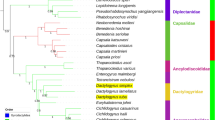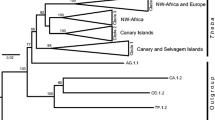Abstract
Nucleotide sequences of the triose phosphate isomerase (TPI) gene (624 bp) and mitochondrial cytochrome b (cob) gene (520 bp) were obtained by PCR and evaluated for utility in inferring the phylogenetic relationships among Trichuris species. Published sequences of one other nuclear gene (18S or SSU rRNA, 1816–1846 bp) and one additional mitochondrial (mtDNA) gene (cytochrome oxidase 1, cox1, 342 bp) were also analyzed. Maximum likelihood and Bayesian inference methods were used to infer phylogenies for each gene separately but also for the combined mitochondrial data (two genes), the combined nuclear data (two genes), and the total evidence (four gene) dataset. Few Trichuris clades were uniformly resolved across separate analyses of individual genes. For the mtDNA, the cob gene trees had greater phylogenetic resolution and tended to have higher support values than the cox1 analyses. For nuclear genes, the SSU gene trees had slightly greater resolution and support values than the TPI analyses, but TPI was the only gene with reliable support for the deepest nodes in the tree. Combined analyses of genes yielded strongly supported clades in most cases, with the exception of the relationship among Trichuris clades 1, 2, and 3, which showed conflicting results between nuclear and mitochondrial genes. Both the TPI and cob genes proved valuable for inferring Trichuris relationships, with greatest resolution and support values achieved through combined analysis of multiple genes. Based on the phylogeny of the combined analysis of nuclear and mitochondrial genes, parsimony mapping of definitive host utilization depicts artiodactyls as the ancestral hosts for these Trichuris, with host-shifts into primates, rodents, and Carnivora.



Similar content being viewed by others
References
Anderson RC (2000) The superfamily trichinelloidea. In: Anderson RC (ed) Nematode parasites of vertebrates: their development and transmission, 2nd edn. CAB International, Wallingford, pp 605–621
Ballard JWO, Rand DM (2005) The population biology of mitochondrial DNA and its phylogenetic implications. Annu Rev Ecol Syst 36:621–642
Cafrune MM, Aguirre DH, Rickard LG (1999) Recovery of Trichuris tenuis Chandler, 1930, from camelids (Lama glama and Vicugna vicugna) in Argentina. J Parasitol 85:961–962
Callejón R, Nadler S, de Rojas M, Zurita A, Petrášová J, Cutillas C (2013) Molecular characterization and phylogeny of whipworm nematodes inferred from DNA sequences of cox1 mtDNA and 18S rDNA. Parasitol Res 112:3933–3949
Callejón R, Halajian A, de Rojas M, Marrugal A, Guevara DC, Cutillas C (2012) 16S partial gene mitochondrial DNA and internal transcribed spacers ribosomal DNA as differential markers of Trichuris discolor populations. Vet Parasitol 186:350–363
Chabaud AG (1974) CIH keys to the nematode parasites of vertebrates. In: Anderson RC, Chabaud AG, Willmott S (eds) Class nematoda. Commonwealth Agricultural Bureaux, Slough, pp 7–17
Cutillas C, de Rojas M, Zurita A, Oliveros R, Callejón R (2014) Trichuris colobae n. sp. (Nematoda: Trichuridae), a new species of Trichuris from Colobus guereza kikuyensis. Parasitol Res 113:2725–2732
Cutillas C, Callejón R, de Rojas M, Tewes B, Úbeda JM, Ariza C, Guevara DC (2009) Trichuris suis and Trichuris trichiura are different nematode species. Acta Trop 11:299–307
Cutillas C, de Rojas M, Ariza C, Úbeda JM, Guevara DC (2007) Molecular identification of Trichuris vulpis and Trichuris suis isolated from different hosts. Parasitol Res 100:383–389
Cutillas C, Oliveros R, de Rojas M, Guevara D (2004) Determination of Trichuris skrjabini by sequentiation of the ITS1-5.8S-ITS2 segment of the ribosomal DNA. Comparative molecular study of different species of trichurids. J Parasitol 90:648–652
Cutillas C, Oliveros O, de Rojas M, Guevara DC (2002) Determination of Trichuris muris from murid hosts and T. arvicolae (Nematoda) from arvicolid rodents by amplification and sequentiation of the ITS1-5.8S-ITS2 segment of the ribosomal DNA. Parasitol Res 88:574–582
De Ley P (2006) A quick tour of nematode diversity and the backbone of nematode phylogeny. In: WormBook (ed) The C. elegans Research Community, WormBook.. doi:10.1895/wormbook.1.7.1, http://www.wormbook.org
De Ley P, Blaxter ML (2002) Systematic position and phylogeny. In: Lee DL (ed) The biology of nematodes. Taylor and Francis, London, pp 1–30
Elliot DE, Summers RW, Weinstock JV (2007) Helminths as governors of immune-mediated inflammation. Int J Parasitol 37:457–464
Gagarin VG (1974) Critical evaluation of measured characters in the differentiation of helminth species (on the model of trichocephalids). In: Tokobaev MM (ed) Fauna gelmintov zivotnych y rastenij kirgizii. ILIM, Frunze, pp 3–9
Ghai RR, Simons ND, Chapman CA, Omeja PA, Davies TJ, Ting N, Goldberg TL (2014) Hidden population structure and cross-species transmission of whipworms (Trichuris sp.) in humans and non-human primates in Uganda. PLoS Negl Trop Dis 8:e3256
Guardone L, Deplazes P, Macchioni F, Magi M, Mathis A (2013) Ribosomal and mitochondrial DNA analysis of Trichuridae nematodes of carnivores and small mammals. Vet Parasitol 197:364–369
Larkin MA, Blackshields G, Brown NP, Chenna R, McGettigan PA, McWilliam H, Valentin F, Wallace IM, Wilm A, Lopez R, Thompson JD, Gibson TJ, Higgins DG (2007) Clustal W and Clustal X version 2.0. Bioinformatics 23:2947–2948
Liu GH, Gasser RB, Su A, Nejsum P, Peng L, Lin RQ, Li MW, Xu MJ, Zhu XQ (2012) Clear genetic distinctiveness between human- and pig- derived Trichuris based on analysis of mitochondrial datasets. PLoS Negl Trop Dis 6:e1539. doi:10.1371/journal.pntd.0001539
Liu G-H, Gasser RB, Nejsum P, Wang Y, Chen Q, Song H-Q, Zhu X-Q (2013) Mitochondrial and nuclear ribosomal DNA evidence supports the existence of a new Trichuris species in the endangered François’ leaf-monkey. PLoS One 8:e66249. doi:10.1371/journal.pone.0066249
Lockhart PJ, Howe CJ, Bryant DA, Beanland TJ, Larkum AWD (1992) Substitutional bias confounds inference of cyanelle origins from sequence data. J Mol Evol 34:153–162
Lockhart PJ, Steel MA, Hendy MD, Penny D (1994) Recovering evolutionary trees under a more realistic model of sequence evolution. Mol Biol Evol 11:605–612
Löytynoja A, Milinkovitch MC (2003) A hidden Markov model for progressive multiple alignment. Bioinformatics 19:1505–1513
Maddison DR, Maddison WP (2000) MacClade 4. Sinauer Associates, Inc., Sunderland
Maddison WP (1997) Gene trees in species trees. Syst Biol 46:523–536
Miller MA, Pfeiffer W, Schwartz T (2010) Creating the CIPRES Science Gateway for inference of large phylogenetic trees. Proceedings of the Gateway Computing Environments Workshop (GCE), New Orleans, pp 1–8
Nadler SA, Pérez-Ponce de León GPP (2011) Integrating molecular and morphological approaches for characterizing parasite cryptic species: implications for parasitology. Parasitology 138:1688–1709
Nadler SA, Carreno RA, Mejía-Madrid H, Ullberg J, Pagan C (2007) Molecular phylogeny of clade III nematodes reveals multiple origins of tissue parasitism. Parasitology 134:1421–1442
Nissen S, Al-Jubury A, Hansen TV, Olsen A, Christensen H (2012) Genetic analysis of Trichuris suis and T. trichiura recovered from humans and pigs in a sympatric setting in Uganda. Vet Parasitol 188:68–77
Nylander JAA (2004) MrModelTest. Evolutionary Biology Centre, Uppsala University, http://www.abc.se/,nylander
Oliveros R, Cutillas C, de Rojas M, Arias P (2000) Characterization of four species of Trichuris (Nematoda: Enoplida) by their second internal transcribed spacer ribosomal DNA sequence. Parasitol Res 86:1008–1013
Pamilo P, Nei M (1988) Relationships between gene trees and species trees. Mol Biol Evol 5:568–583
Park J-K, Sultana T, Lee S-H, Kang S, Kim HK, Min G-S, Eom KS, Nadler SA (2011) Monophyly of clade III nematodes is not supported by phylogenetic analysis of complete mitochondrial genome sequences. BMC Genomics 12:392
Pérez-Ponce de León G, Nadler SA (2010) Critical Comment. What we don’t recognize can hurt us: a plea for awareness about cryptic species. J Parasitol 96:453–464
Ravasi DF, O’Riain MJ, Davids F, Illing N (2012) Phylogenetic evidence that two distinct Trichuris genotypes infect both humans and non-human primates. PLoS One 7:e44187
Reddy A, Fried B (2007) The use of Trichuris suis and other helminths therapies to treat Crohn’s disease. Parasitol Res 100:921–927
Robles MR, Cutillas C, Panei CJ, Callejon R (2014) Morphological and molecular characterization of a new Trichuris species (Nematoda-Trichuridae), and phylogenetic relationships of Trichuris species of Cricetid rodents from Argentina. PLoS One 9(e112069):e112069. doi:10.1371/journal.pone.0112069
Ronquist F, Huelsenbeck JP (2003) MrBAYES 3: Bayesian phylogenetic inference under mixed models. Bioinformatics 19:1572–1574
Salaba O, Rylková K, Vadlejch J, Petrtýl M, Scháňková Š, Brožová A, Jankovská I, Jebavý L, Langrová I (2013) The first determination of Trichuris sp. from roe deer by amplification and sequenation of the ITS1-5.8S-ITS2 segment of ribosomal DNA. Parasitol Res 112:955–960
Smythe AB, Sanderson MJ, Nadler SA (2006) Nematode small subunit phylogeny correlates with alignment parameters. Syst Biol 55:972–992
Spakulová M (1993) Discriminant analysis as a method for the numerical evaluation of taxonomic characters in male trichurid nematodes. Syst Parasitol 29:113–119
Stamatakis A (2006) RAxML-VI-HPC: maximum likelihood-based phylogenetic analyses with thousands of taxa and mixed models. Bioinformatics 22:2688–2690
Sultana T, Kim J, Lee SH, Han H, Kim S, Min GS, Nadler SA, Park JK (2013) Comparative analysis of complete mitochondrial genome sequences confirms independent origins of plant-parasitic nematodes. BMC Evol Biol 13:12. doi:10.1186/1471-2148-13-12
Summers RW, Elliott DE, Urban JF Jr, Thompson R, Weinstock JV (2005) Trichuris suis therapy in Crohn’s disease. Gut 54:87–90
Wang Y, Liu G-H, Li J-Y, Min-Jun Xu M-J, Ye Y-G, Zhou D-H, Song H-Q, Rui-Qing Lin R-Q, Zhu X-Q (2013) Genetic variability among Trichuris ovis isolates from different hosts in Guangdong Province, China revealed by sequences of three mitochondrial genes. Mitochondrial DNA 24:50–54
Wernersson R, Pedersen AG (2003) RevTrans—constructing alignments of coding DNA from aligned amino acid sequences. Nucleic Acids Res 31:3537–3539
Acknowledgments
This research was funded by the U.S. National Science Foundation PEET grant (DEB-0731516) and the Spanish Ministry of Science and Technology (CGL2008-01459/BOS).
Author information
Authors and Affiliations
Corresponding author
Rights and permissions
About this article
Cite this article
Callejón, R., Cutillas, C. & Nadler, S.A. Nuclear and mitochondrial genes for inferring Trichuris phylogeny. Parasitol Res 114, 4591–4599 (2015). https://doi.org/10.1007/s00436-015-4705-7
Received:
Accepted:
Published:
Issue Date:
DOI: https://doi.org/10.1007/s00436-015-4705-7




